Introduction
The PlayFull Dual Zi12 is set to retail for around $199 and will be available in white or black.
Lens & Imaging System
{{section_header}}{{section.name}}{{/section_header}}

The Kodak PlayFull Dual Zi12 comes with a fixed lens that has one interesting trick we've never seen before on an ultracompact camcorder: a tiny automatic lens cover. Not that a lens cover is something anyone will jump for joy about, but it's an interesting feature nonetheless. Besides the cover, the 4.7mm lens also features a fixed f/2.6 aperture. The sensor is a large, 12-megapixel CMOS, which is what enables the PlayFull Dual to capture high-resolution still images.
Front
{{section_header}}{{section.name}}{{/section_header}}
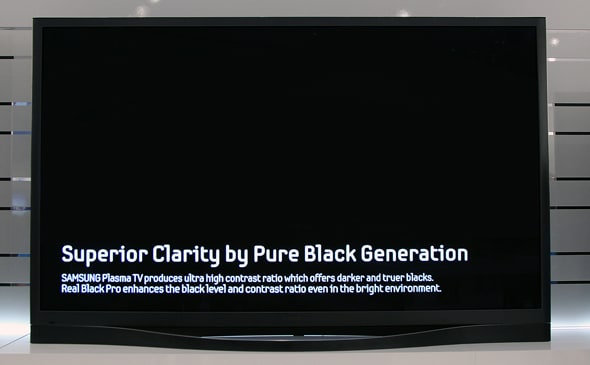
Right
{{section_header}}{{section.name}}{{/section_header}}
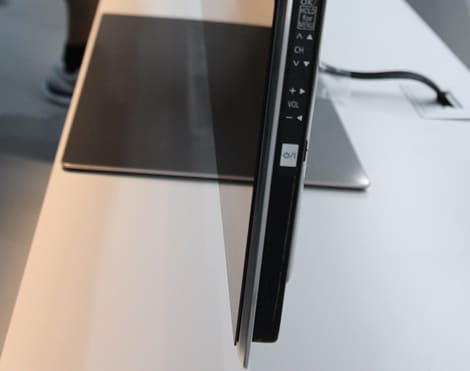
Back
{{section_header}}{{section.name}}{{/section_header}}
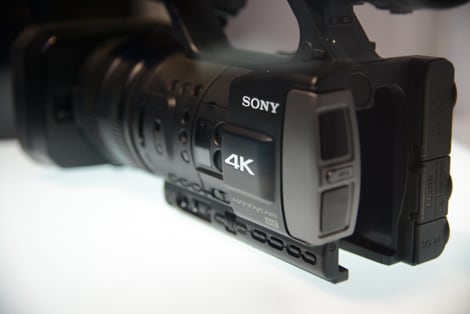
Left
{{section_header}}{{section.name}}{{/section_header}}

Top
{{section_header}}{{section.name}}{{/section_header}}

Bottom
{{section_header}}{{section.name}}{{/section_header}}
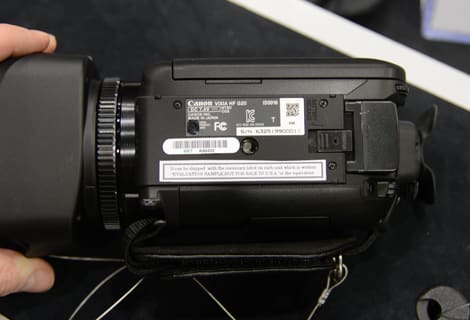
Compression
{{section_header}}{{section.name}}{{/section_header}}
Using MPEG-4 compression, the Kodak PlayFull Dual offers five different recording options. There's two Full HD settings (1080/60p and 1080/30p), two 720p recording options (60p and 30p), and one WVGA standard definition mode.
Read more about the advantages and disadvantages of different compression types.
We should also note how different the video looks if you record holding the Dual vertically rather than horizontally. Holding it horizontally will record a 16:9 widescreen video image that is perfect for viewing on an HDTV. Holding the camcorder vertically will record a tall and thin image with large swaths of black on either side—something that may look good when viewed on the camcorder itself, but not on a widescreen monitor.
Media
{{section_header}}{{section.name}}{{/section_header}}
There's no internal memory on the PlayFull Dual Zi12 (or, at least, not enough for Kodak to make mention of it), so you'll need to get an SD or SDHC memory card to insert in the camcorder before you can start shooting video. It doesn't look like the Dual works with high-capacity SDXC memory cards, but that doesn't matter. SDHC cards, which go up to 32GB, are plenty big for a pocket-cam like this.
Read more about the advantages and disadvantages of different media types.

Editing
{{section_header}}{{section.name}}{{/section_header}}
Being a Kodak, the PlayFull Dual is equipped with a special "share" button on the bottom of the camcorder. We like the share button and the supplied share button app that comes with the Dual (and all Kodaks), but you do still need to connect the camcorder to a computer to share videos on the web. We just like the simplicity of the application, although we wish Kodak would introduce a streamlined WiFi component on a PlayFull camcorder in the near future (so you could share video without connecting to a computer first).
Auto Mode
{{section_header}}{{section.name}}{{/section_header}}
All of the major controls on the Dual are handled automatically, which means you don't have to worry about adjusting exposure, focus, aperture, shutter speed, or white balance manually. We didn't get a good idea of how well these controls functioned in our time with the camcorder, but we'll take a thorough look when we get the camcorder into our labs later this year.
The PlayFull Dual includes a number of enhanced auto modes, including a variety of digital effects, face detection, and a suite of scene modes. You can read about most of these features below.

Scene Modes
The little switch on the top of the camcorder allows you to use the Kodak PlayFull Dual with a variety of scene modes. The options to choose from include: Portrait, Landscape, Children, Self-portrait, Night Portrait, Night Landscape, and two high-speed record modes (for slow motion video). The inclusion of these scene modes is something that sets the Dual apart from previous Kodak camcorders, so if this is something you've wanted before, Kodak may have listened to your demands.
The final scene mode on the camcorder is an Auto Panorama setting, which works for taking still images only.
Zoom
Focus
{{section_header}}{{section.name}}{{/section_header}}
Like we said, there's no manual focus option on the Zi12, but there is an option to switch between regular and macro focus for close-up shots.
Color & Image Controls
{{section_header}}{{section.name}}{{/section_header}}
The same slider on the top of the camcorder that allows you to select from various scene modes has another setting for digital effects. The effects alter the look of your video and they're each named after a different type of Kodak film stock—something that will surely appeal to old-school photographers.
The effects options include: Kodacolor (based on Kodak's color negative film), Ektachrome (a faster color film), Kodachrome (a color reversal film), T-Max (tabular-grain black and white negative), Tri-X (high-speed black and white), and Sepia (warm, brown-gray color). These naming conventions are cool to us, but we doubt most users of the PlayFull Dual will understand the references.
Ease of Use
{{section_header}}{{section.name}}{{/section_header}}
The PlayFull Dual is definitely more complex and has more features than your average ultracompact camcorder, but it's still a very simple device compared to a traditional model. The menus are easy to navigate and we love the interface of Kodak's Share Button application. The program still requires you to connect the camcorder to a computer to upload your video to the web, but it's an intuitive, simple process (and the app works on both Macs and PCs).
The half camera, half camcorder design of the PlayFull Dual can be a bit confusing, and it's possible that some users will find the rotating screen system difficult to understand. The Apple iPhone and iPod Touch, as well as the Sony Bloggie camcorders have similar screen rotation features, so it is likely that this kind of thing will become more and more popular each year.
The most frustrating thing we experienced with the PlayFull Dual had to do with the camcorder's poorly-designed buttons, which you can read more about in the handling section below.
Handling
{{section_header}}{{section.name}}{{/section_header}}
The Kodak PlayFull Dual, like most Kodak camcorders, has a few glaring problems with handling that were impossible to overlook. The camcorder felt good in our hands for the most part, and we liked the rubbery texture of the Dual's front side (it made it easier to grip). The problem with the camcorder, however, is that the buttons are poorly-designed, which resulted in frustrating menu navigation.
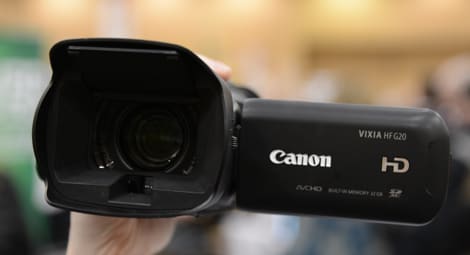
How poorly designed are the buttons? Well, in our time with the camcorder, we found ourselves consistently yelling at the directional pad to actually do what we wanted it to do. We'd press the OK button at the center of the d-pad, and the menu would move us down instead. Often the opposite would happen when we'd try to scroll down, as the camcorder would make a menu selection instead. Little things like this can be overlooked by some users, but it drove us batty and it made us want to avoid the Dual's menu system altogether.

We also found the start/stop record button was slow to respond and often took a few pushes to actually get recording to stop. The auto screen rotation that we talked about in the previous section is a cool function, but the screen always took a bit too long to rotate after we turned the camcorder (and sometimes it would "forget" to rotate altogether). We've seen this problem on most devices with a rotation feature, however, so it's not something that is a Kodak-only problem.
While the PlayFull Dual did feel good in our hand, with a solid grip and a compact design, we did find ourselves struggling to get the camcorder to stand up on its own. The rounded bottom of the Dual made this difficult, but we were able to get it to stand up straight on a completely flat surface (like a glass table), while surfaces with more fluctuation (like a picnic table or a cushion) were difficult to balance the camcorder on.

Stabilization
{{section_header}}{{section.name}}{{/section_header}}
The Dual comes with built-in DIS (digital image stabilization), just like previous Kodak camcorders. Unfortunately, it didn't look like the DIS could be turned off on the camcorder, which may make it impossible for us to test the feature in our labs.
Portability
{{section_header}}{{section.name}}{{/section_header}}
The PlayFull Dual is obviously very portable, it's is a pocket camcorder after all. The fact that it lacks internal memory does mean you have to bring along a memory card wherever you go, but that won't add any weight or bulk to the camcorder (it just adds one more thing you need to remember).
The Dual is 2.3 x 4.3 x 0.6 inches, which isn't much different to the proportions of the previous Kodak Zi8 (which Kodak claims as the natural predecessor to the Dual). The two original PlayFull camcorders—the Ze1 and the Ze2 (waterproof)—were quite a bit smaller and lighter than the PlayFull Dual, but neither had a 3-inch LCD like the PlayFull Dual is equipped with. Besides, does an half-inch or so really matter when you're dealing with a product that's small enough to fit in your pocket with ease?
Battery
{{section_header}}{{section.name}}{{/section_header}}
The battery compartment on the PlayFull Dual is so well camouflaged that we almost missed it during our photography session with the camcorder at CES. To open the compartment, you simply slide the front panel off of the camcorder (the entire area that's below the lens). Here' you'll find a thin battery pack that fits snugly inside the body of the camcorder. Kodak claims the PlayFull Dual has an 80 minute battery life, which isn't that great, but we'll wait for our own battery test before passing judgement.

LCD & Viewfinder
{{section_header}}{{section.name}}{{/section_header}}
The Dual has a 3-inch LCD—a good size for an ultracompact camcorder that is just over 4-inches tall. In the camcorder's menu system you'll find options for LCD brightness control and a glare shield setting... but trust us, this LCD will be a challenge to use in strong glare situations despite the glare shield option.



Menus
Audio Features
{{section_header}}{{section.name}}{{/section_header}}
Not only does the PlayFull Dual Zi12 have a built-in microphone with audio level control, but it also has a 3.5mm microphone jack on the left side of the camcorder. The presence of this mic jack is one of the reason Kodak considers the Dual the true successor to the Zi8 camcorder from a few years ago (as it too had a 3.5mm mic jack).

Connectivity
Still Features
Other Features
{{section_header}}{{section.name}}{{/section_header}}
High Speed Recording
We're big fans of the high-speed recording options on the Kodak PlayFull Dual, although we admit they are gimmicky and aren't for everyone. The Dual has two options for high-speed recording: 120fps and 240fps, both of which record at a 1280 x 720 resolution. The video appears to be in ultra slow motion when played back at regular speed, so it's great for shooting action sequences with lots of quick movement.
Conclusion
Is there still a market for a hybrid camera/camcorder device that places equal weighting on both video and photo capabilities? With the launch of the PlayFull Dual Zi12, Kodak is certainly hoping so. The Dual camcorder can record Full HD video, capture 12-megapixel still photos, and has a variety of special features and controls that aren't normally found on ultracompact camcorders.
Kodak is banking on the idea that people want a compact camcorder that has a bit more to it than simple automatic controls. The PlayFull Dual's price point of $199 is certainly competitive, and it is possible that people are willing to shell out a bit more cash for a larger LCD and an external mic jack (in addition to the digital effects and scene modes).
Kodak has usually left us impressed by its compact camcorders, so we're excited to bring the PlayFull Dual into our labs—despite the fact that we've usually been less than fond of models that try too hard to be a true video/photo hybrid device.
Photo Gallery
{{photo_gallery "FI Lens Image", "FI Front Image", "FI Right Image", "FI Back Image", "FI Left Image", "FI Left Open Image", "FI Top Image", "FI Bottom Image", "FI Media Image", "FI Easy Mode Image", "FI Zoom Image", "FI Zoom Image 2", "FI 3D Lens Image", "FI 3D Lens Image 2", "FI 3D Physical Controls", "FI 3D Physical Controls 2", "FI Handling Image", "FI Handling Image 2", "FI Handling Image 3", "FI Battery Image", "FI LCD Image", "FI Viewfinder Image", "FI Viewfinder Image 2", "FI Playback Image", "FI Mic Image", "FI Flash Image", "FI Photo Mode Image", "FI Ports Image 1", "FI Ports Image 2", "FI Ports Image 3", "FI Ports Image 4", "FI Ports Image 5", "FI Ports Image 6"}}
Specs
{{manufacturer_specs_table}}
Meet the tester
Jeremy is the video expert of our imaging team and Reviewed.com's head of video production. Originally from Pennsylvania and upstate NY, he graduated from Bard college with a degree in film and electronic media. He has been living and working in New England since 2005.
Checking our work.
Our team is here for one purpose: to help you buy the best stuff and love what you own. Our writers, editors, and lab technicians obsess over the products we cover to make sure you're confident and satisfied. Have a different opinion about something we recommend? Email us and we'll compare notes.
Shoot us an email
